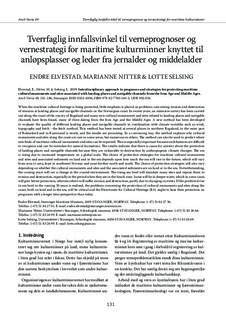| dc.description.abstract | When the maritime cultural heritage is being protected, little emphasis is placed on problems concerning erosion and destruction
of remains at landing places and navigable channels on the Norwegian coast. In recent years, an extensive survey has been carried
out along the coast of the county of Rogaland and many new cultural monuments and sites related to landing places and navigable
channels have been found, many of them dating from the Iron Age and the Middle Ages. A new method has been developed
to evaluate the quality of different landing places and navigable channels in combination with climate variables such as wind,
topography and fetch - the fetch method. This method has been tested at several places in northern Rogaland, in the outer part
of Boknafjord and in Karmsund (a strait), and the results are promising. In a convincing way, the method explains why cultural
monuments and sites along the coast are rare in some areas, but numerous in others. The method can also be used to predict where
new finds of maritime cultural monuments and sites can be expected. This is especially important because such features are difficult
to recognise and can be mistaken for natural formations. The results indicate that there is cause for anxiety about the protection
of landing places and navigable channels because they are vulnerable to destruction by anthropogenic climate changes. The sea
is rising due to increased temperature on a global scale. The choice of protection strategies for maritime cultural monuments
and sites and associated sediments on land and in the sea depends upon how much the sea will rise in the future, which will vary
from area to area, least in southwest Norway and most further north and south. The choice of protection strategies will also vary
depending on whether the cultural monuments and sites and the associated sediments are on land or in the sea. Notwithstanding,
the coming years will see a change in the coastal environment. The rising sea level will inundate many sites and expose them to
erosion and destruction, especially in the period when they are in the beach zone. Some will be in deeper water, which in some cases
will give better protection, whereas others will suffer erosion and destruction, partly due to changing currents. If the predicted rise
in sea level in the coming 50 years is realised, the problems concerning the protection of cultural monuments and sites along the
coast, both on land and in the sea, will be critical and the Directorate for Cultural Heritage (RA) ought to base their protection on
prognoses with a longer time perspective than today. | nb_NO |
